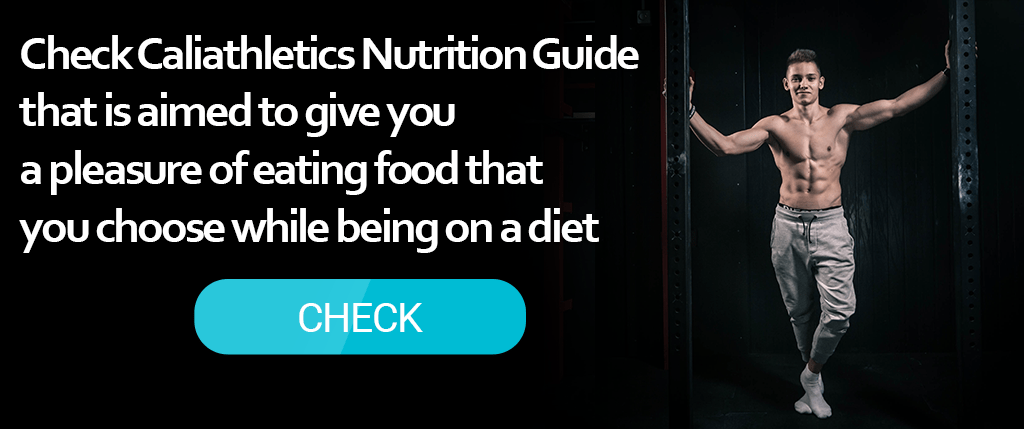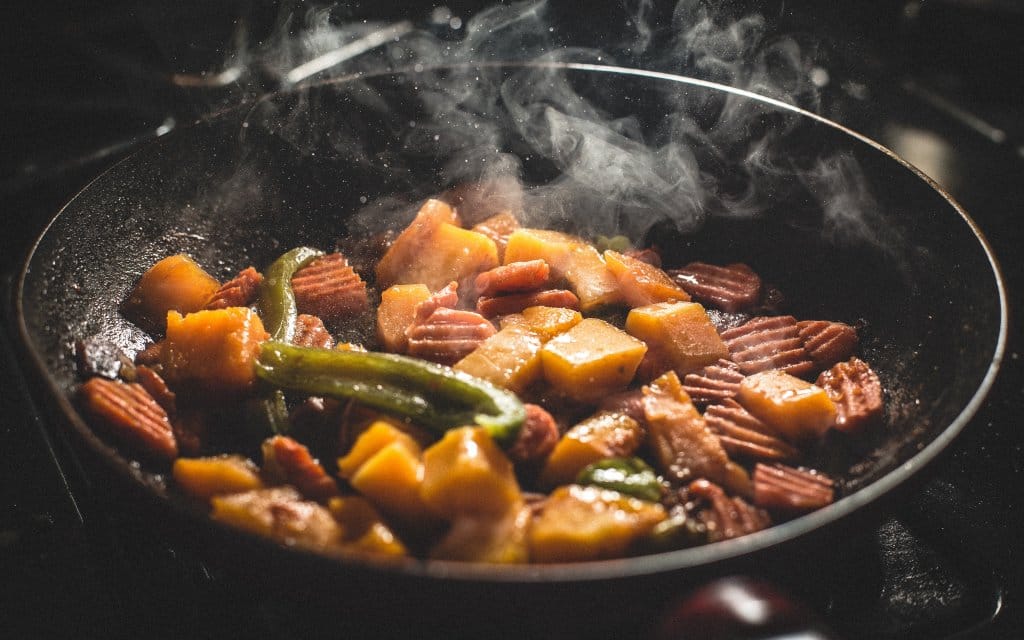
Calisthenics Nutrition
Calisthenics diet for muscle gain
If you are working out towards your goal you should eat accordingly. Recall section of hypertrophy training – if you want to gain muscle mass you need to follow a diet that will complement your training schedule. This section is all about it. I have always been reluctant to strict diet plans as they are really hard to stick to and few people actually do it. I myself found it hard. That is why I focus on principles of how to eat that you can incorporate to your everyday diet. Do not rush, it is much better to incorporate these eating habits step by step but being consistent with it rather than being super strict about your diet just for a week or two.
Before you begin diet
Each of us has different bodies and leads different lifestyles. By eating food our body gets energy to get things done and function properly. Some people eat more, some people eat less. Every person has their own caloric needs that needs to fulfil to fuel their body. So what now? You need to
calculate your own caloric needs. An average healthy male will need around 2500kcal to maintain his physique. I covered the detailed process of calculating your own required caloric intake in my Nutrition Guide, but feel free to learn how to do it on your own – there are many resources online. I just covered the best, in my view, method and simplified it so everyone can easily apply it. You can get it here.
Gaining muscles
The idea is simple, it all boils down to simple maths.
CALORIES IN > CALORIES OUT
That means that you have to consume more calories than you burn throughout the day. In short, eat A LOT. The problem is that many people think that they already do eat enough, but in fact they are still below their caloric needs. More specifically, if you want to develop muscle mass add to your
required caloric intake extra 200-500 kcal a day.
For example: 3000 kcal (daily caloric needs) + 400 kcal = 3400 kcal
Losing body fat
Similarly to above concept, except the principle is reversed.
CALORIES IN < CALORIES OUT
Basically try to burn more calories throughout the day than you consume. Do not rush, however, with cutting down all your calories to 0. I would recommend that at first your daily deficit of calories should not exceed 200-500.
For example, 2500 (daily caloric needs) – 400 kcal = 2100 kcal
Food quality, micronutrients and water
Last thing I wanted to mention is the quality of food in our diet. Whilst you have probably heard that healthy living entails healthy eating let’s just focus here on how healthy food can influence losing weight and building muscles.It comes out things are pretty simple. As long as you keep your calories in check you could easily get away with eating all sorts of junk food. In the end vitamins and microelements can be supplemented so that is not a big deal. Sounds amazing, right? Frankly speaking, the quality food makes you feel full for much longer and this is the only valid argument behind healthy food. Not having to walk around hungry all the time certainly makes it helpful if you want to lose some extra kilograms. Now there is a problem, however, if you want to build some mass. For people who want to bulk up some junk food may come in handy. Restricting your diet to chicken, rice and oats might not be the best idea. This is due to the fact that whilst it is a great source of energy for your body, the high fibre it contains fills you up for a rather long time. Based on my own experiences, I can tell you that it might actually be advised to have some bad food in your diet every now and then. Not only does it easily deliver required calories but treating yourself with some pizza helps mentally, right? For as long as you do not let the caloric surplus get out of hand, you will build lean muscle mass.
So if you are struggling with putting on weight, my recommendation for you is to go 70% clean and 30% dirty.
What also matters is your body type. There are three body types, ectomorphs, mesomorphs and endomorphs. Everyone of us has one of these bodies or a mixture of them. You should take it into account when preparing your diet plan. Check this article if you want to learn more.
What now? – Applying that knowledge
Okay so you have read and understood everything that I wrote in previous sections. You may be thinking, okay, what to do now? How do I apply that knowledge for my workouts? This, indeed, may seem as a daunting task but do not be overwhelmed. It takes time to get digest everything and
learning is a constant process – it does not finish here. Check my website and my programs if you want to see how I applied this knowledge for you already there. But do not worry, I will briefly write how you can do it yourself as well.
What are your goals
Give it a think what do you want to do. Your workout plans will vary depending if you want to learn skills, build muscles or increase muscular endurance. Of course, you develop your body comprehensively through training but only by focusing on certain types of training will you achieve
over-average results in that area. Be reasonable about it, do not try to learn how to muscle up if you cannot do a few strict pull ups yet. Build your strength and endurance step by step and focus on developing strong base in the first place.
Choose exercises that will match your goals. If you want to learn skills do preparatory movements and progressions of these exercises. If you want to build strength do weighted exercises or harder variations of basic movements. Consider an example of an athlete who wants to learn how to muscle
up. This person should focus on building dynamic strength of a pulling movement. Therefore, exercises such as Australian pull ups or bodyweight rows might not be as useful as high pull ups or explosive pull ups because there is a little overlap between them and muscle up. That being said,
choosing a certain way of training typically entails a type of exercises that you will perform.
Decide how many days a week would you like to workout. For the beginners I would recommend Full Body Workout 3 or 4 times a week. Try to combine previously mentioned exercises into 3 different workout routines. Make sure that during each session you train your whole
body – not only chest and biceps. However, you can also choose to train using split training method.
The choice is yours.
Frequently Asked Questions
Nutrition
I eat a lot but still cannot gain weight.
You should check if you are eating enough calories with correct nutrients, doing hypertrophy trainings and sleeping decent amount of time. After all, during workout you damage your muscle cells which are then repaired when you sleep after you fuelled your body with proper food. So make sure you eat a lot, train well (but do not overtrain!) and recover well. How to do it? First of all you should calculate your caloric needs and then add 200-500 calories on top of it. For more details go here. http://www.caliathletics.com/buy/nutrition-guide/.
I almost do not eat anything but still cannot lose weight.
Same as above, do you eat below your caloric needs but enough to have metabolism working right?
Remember to stay hydrated and drink a lot of water.
Should I buy protein powder to build muscles?
The very first thing you should focus on is your well-balanced diet with caloric surplus or deficit – depending on your goal. As people say, it all starts in the kitchen. Regular food that you eat should fulfil all your protein needs without the need for supplements. Protein powder only may come
handy if you struggle with eating regular meals, if you are on a vegan diet or allergic to some products. It really is not necessary to use it in order to bolster muscle growth, but if you really want to add it to your diet then I would only recommend to take if after the workout in the amount of 30g of protein. It might be easier for some people that do not have enough time to cook or are too lazy for that.
How to deal with lack of appetite?
It may be a problem for a lot of people to increase their daily caloric intake from, for example, 2000 to 300. Even I sometimes struggle with eating as much as I should. Hopefully, there are was around it. Firstly, let’s focus on the products you choose. Whilst quality of food is an important factor, you have to find balance. If you are having a hard time delivering the necessary, number of calories per day then you can cheat a little by including some of the ‘bad food’ in order to fill in for the missing calories. Also, keep in mind that products such as oats, brown rice, among others, are high in fiber which controls the blood sugar as well as digestion system and contributes to feeling satiety (i.e. feeling full). Cutting a bit on fiber might help as well. Secondly, hydration. If you are not drinking enough your appetite will be low. In my case it is best demonstrated right after I wake up. Dehydrated after sleep, I never feel like eating. This is why one of the first things I do is to grab a glass of water or an orange juice (my favourite) to boost up the appetite. Thirdly, milkshakes (especially with mixed oats, fruits, seeds and nuts – which have the most calories) are nice way to speed up the digestion and deliver the necessary nutrients in a fairly lightweight form.
Can I eat junk food and still lose weight?
Basically, it is not really the food that makes you obese, but rather the number of calories you eat. So called junk food is jam-packed with those so keeping your calories in check might be a problem (also, do not forget about providing right amount of minerals and vitamins). That leads us to the
conclusion that many people will be glad to hear: you do not have to give them up entirely to lose weight. Just remember not to exceed your daily requirement of calories and you will be fine.




